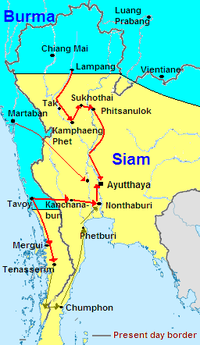Siamese-Burmese War 1764–1769
| date | 1764 to 1769 |
|---|---|
| place | Siam and Laos |
| Casus Belli | Burmese expansion and Siamese reaction |
| output | Burmese invasion of Siam and Laos ; Destruction of Ayutthaya; then expulsion of the Burmese from Siam |
| Parties to the conflict | |
|---|---|
|
|
|
| Commander | |
|
until 1767: King Ekathat |
Hsinbyushin , represented by General Maha Nawraha († 1767)
|
The Siamese-Burmese War 1764–1769 was a military conflict between the Siamese Empire of Ayutthaya and the Burmese Empire of Ava of the Konbaung dynasty . It led to the second and final destruction of Ayutthaya .
prehistory
After the local ruler Alaungphaya (1714–1760) had reunited Burma and founded a new dynasty, he undertook a series of campaigns of conquest that also took him east to Siam. There he died, however, during the Burmese siege of Ayutthaya. Subsequently, disputes over the succession began, from which the expansionist-oriented Hsinbyushin (r. 1760 to 1776) emerged as the new king.
course
Hsinbyushin turned first with a larger force in the north of what is now Thailand to Chiang Mai , which he defeated after a short resistance. Then he went on to the northeast to what is now Laos . After conquering it, he moved south to attack Ayutthaya and besieged it with around 50,000 soldiers . On January 20, 1766, the Siamese made a sortie with about the same troop strength, but their vanguard was so panicked by a volley of muskets that they fled back into their own ranks. Thousands of Siamese were killed by the pursuing Burmese.
Siam tried to provide relief with around 10,000 men, but the Burmese held their positions, even in the rainy season , which was otherwise rather uncomfortable , when the soldiers were mostly exhausted. In December 1766, the Siamese made one last effort to break the siege by using gunboats to attack the Burman's underwater entrenchments. They were repulsed again with great losses. Phaya Taksin (1734–1782), who later reigned as king, withdrew from the capital with around 500 soldiers in order to build up a new force in the east of the country.
Throughout April 1767, during the hot season in Southeast Asia, the Burmese filled the corridors and tunnels that they had dug under Ayutthaya's city walls with straw and firewood. They set fire to the mass, which ignited into a large fire and collapsed the city wall. The Burmese stormed the city, killing many thousands of Siamese, including King Ekathat , and taking about 30,000 prisoners to Burma. Ayutthaya was so completely devastated that rebuilding was out of the question. Many Buddha images, temples and art treasures were looted and destroyed. The Burmese melted the gold from the precious statues and also destroyed the kingdom's state archives.
As early as 1768, King Taksin had personally put together a larger force, which now systematically proceeded against the Burmese with the aim of driving them out of the country. This succeeded in 1769, with which the unity of Siam was restored.
consequences
The complete destruction of the capital Ayutthaya did not allow a quick reconstruction, so the Siamese built a new one in Thonburi . King Taksin then made it his business to withdraw the Kingdom of the Tai Yuan of Lan Na (Chiang Mai) from Burmese suzerainty, which led to the Siamese-Burmese War (1775–1776).
Individual evidence
- ↑ Damrong Rajanubhab: Rueang thai rop phama khrang krung kao. 1917 (English: Our Wars with the Burmese. Thai-Burmese conflict 1539-1767. Translated and edited by Chris Baker . White Lotus, Bangkok 2001, ISBN 9747534584 , pp. 311–341.)
literature
- Charles Phillips and Alan Axelrod: Encyclopedia of Wars . 3 Vols. New York: Facts on File 2004. ISBN 978-0-8160-2851-1 .

